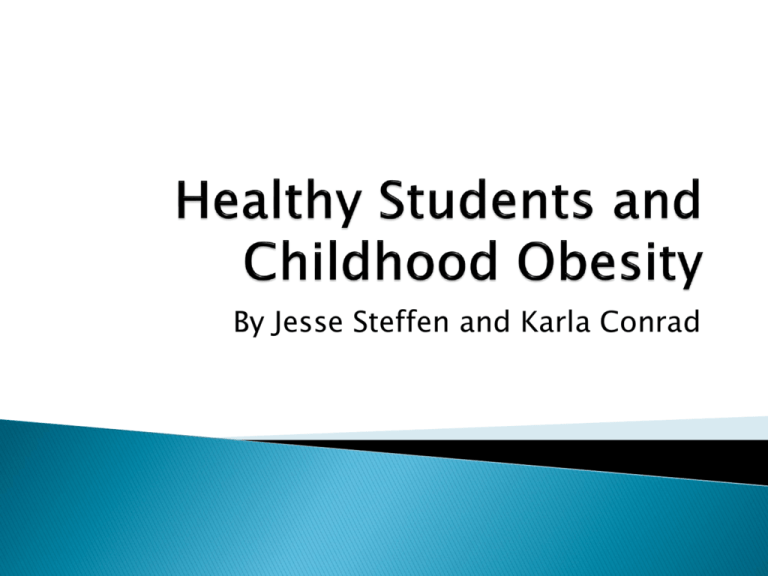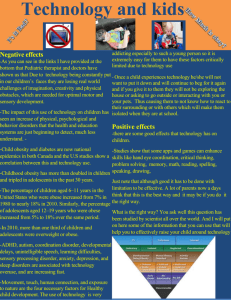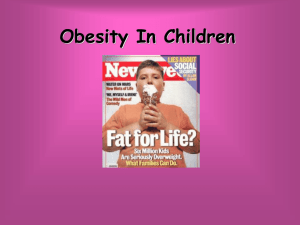Power Point - About Manchester
advertisement

By Jesse Steffen and Karla Conrad What are they eating? On average middle school aged children should intake about 1500-1800 calories. 30% from fat (about 495) Increase as the children are more physically active or are going through a growth spurt. • 476 calories/203 from fat • 331 calories / 131 from fat •420 calories / 170 from fat •273 calories / 176 from fat • 273 calories/ 116 from fat Carbohydrates: Five or more servings per day Fruits: Two to three servings per day Protein: Three or more servings per day Vegetables: Two to three servings of cooked or raw vegetables per day ◦ 1 cup of potatoes, pasta, or rice; 2 slices whole grain bread, ¾ cup dry cereal, ¾ muffin or bagel. ◦ 1 cup canned fruit, 1 piece fresh fruit, ½ cup juice. ◦ 2 to 3 ounces meat, fish, or poultry; 1 egg; ½ cup cottage or ricotta cheese; 1 to 2 ounces of other types of cheese; ½ cup cooked dried beans or legumes; 3 tablespoons peanut butter. ◦ ½ cup of vegetables. Schools are now provided with these nutritional needs. They must provide one‐third of the protein, Vitamin A, Vitamin C, iron, calcium, and calories each day. Overweight and obesity = ranges of weight that are greater than what is generally considered healthy for a given height Childhood obesity = imbalance of food taken in and food used BMI: Body Mass Index ◦ = weight/ (height X height) X 703 ◦ Child and Teen BMI Calculator 2005 Federal Government had to create a program for schools to calculate their students’ BMI Used to evaluate the effectiveness of health and nutrition programs Estimated 17 percent of children and adolescents ages 2-19 years are obese Between 1976-1980 and 2007-2008 obesity increased from 6.5 to 19.6% among 6-11 year olds. Among adolescents aged 12-19, obesity increased from 5 to 18.1% during the same period Average weight for a 10 yr old boy in 1963 was 74 lbs by 2002 the ave. weight was nearly 85 lbs. For girls it went from 77 to 88. Behavioral Factors ◦ Energy intake: large portion sizes, eating meals away from home, frequent beverages ◦ Sedentary behavior On average kids spend 5 ½ hours watching tv. Teens spend on average 6 hrs a day on media driven sedentary activities. ◦ Physical activity Only 10% of schools offer daily physical education classes, and many of those don’t meet the time requirements of weekly exercise. Daily participation in school physical education among adolescents dropped 14 percentage points over the last 13 years — from 42% in 1991 to 28% in 2003 As of 2006 1/3 of 15 yrs olds got the min amount of required physical activity during the week, and on weekends it dropped to just 17%. Genetic Factors Environmental Factors ◦ Within the home ◦ Within child care Almost 80% of children aged 5 years and younger with working mothers are in child care for 40 hours a week on average. ◦ Within schools ◦ Within the community Psychosocial Risks ◦ targets of early and systematic social discrimination ◦ low self-esteem Cardiovascular Disease Risks ◦ high cholesterol levels, high blood pressure, and abnormal glucose tolerance. ◦ In a sample of 5 to 17-year-olds, 70% of obese children had at least one CVD risk factor while 39% of obese children had two or more CVD risk factors Additional Health Risks ◦ Asthma ◦ Hepatic steatosis fatty degeneration of the liver ◦ Sleep apnea 7% of obese children ◦ Type 2 diabetes. Cause CVD and kidney failure Obese children and adolescents are more likely to become obese as adults ◦ 80% of children who were overweight at aged 10–15 years were obese adults at age 25 years. ◦ 25% of obese adults were overweight as children ◦ If overweight begins before 8 years of age, obesity in adulthood is likely to be more severe. Indiana is currently developing a obesity prevention plan. ◦ collection of height and weight data in grades 3, 5, and 7 ◦ promote calorie menu-labeling Michelle Obama/White House Task Force on Childhood Obesity ◦ Goal: Cut Child Obesity From 20% to 5% by 2030 Healthy weight. (2010, June 28). Retrieved from http://www.cdc.gov/healthyweight/ index.html DeNoon, D.J. (2010, May 11). Michelle obama's plan to end childhood obesity epidemic. WebMD, Retrieved from http://children.webmd.com/news/20100511/michelle-obamaplan-to-end-child-obesity-epidemic Tween nutritional requirements. (n.d.). Retrieved from http://life. familyeducation.com/tween/healthy-lifestyle/55985.html Nutrient standards. (n.d.). Retrieved from http://www.fns.usda.gov/tn/resources/NAP1.pdf National school lunch program. (n.d.). Retrieved from http://www. fns.usda.gov/cnd/lunch/aboutlunch/NSLPFactSheet.pdf







